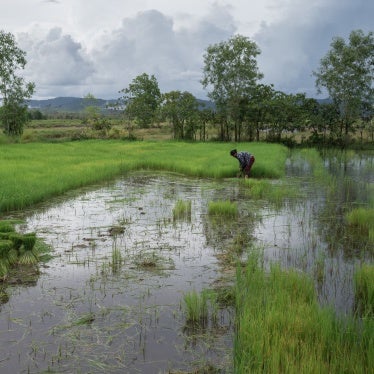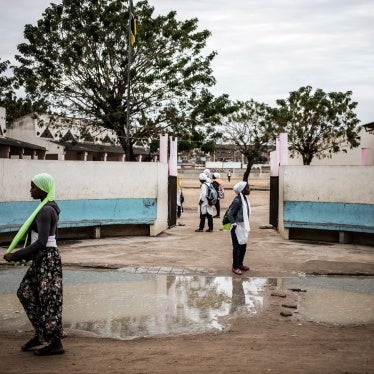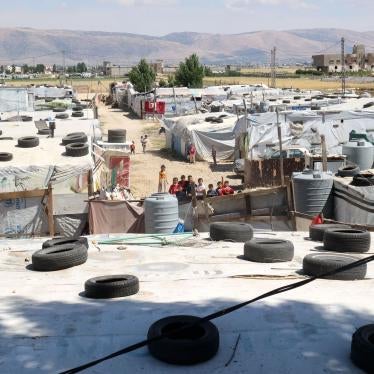Human Rights Watch welcomes the opportunity to comment further on the Code of Practices of the Responsible Jewellery Council (RJC), as part of the final review period of the Code of Practices. We are also participating in the RJC’s multi-stakeholder Standards Committee, which deals with the review; however, we wish to make clear that participation in the Committee does not constitute an endorsement of the Code of Practices.
The revision of the Code of Practices is an opportunity to break new ground and set a high, human rights-based standard in the context of the gold, platinum, and diamond industries. While we appreciate that the new draft Code contains more clear references to some international law and standards, we are concerned that the draft still contains shortcomings in a number of areas, after several rounds of consultations. The Code of Practice risks becoming a weak voluntary standard that falls short of international legal standards and international norms in several places. In addition, the current certification system has flaws that could result in certification of companies that violate provisions of the Code.
Human Rights Watch has carried out extensive research on business and human rights issues generally, including on human rights and mining in India, Papua New Guinea, Ghana, Mozambique, Zimbabwe, Zambia, Mali, Nigeria, and the Democratic Republic of Congo. The following comments on selected sections of the current draft Code of Practices draw on our research findings. They also build on our comments submitted in August 2012.
Sourcing from Artisanal and Small-Scale Mining (section 7)
In the draft Code, Members that source directly from artisanal and small-scale mining (ASM) producers are required to regularly assess risks of forced labor, worst forms of child labor, unsafe working conditions, uncontrolled mercury use, and other significant environmental impacts. They are also required to“use best endeavors to positively influence practices and reduce or avoid risks”.
This provision should include more specific due diligence requirements. In particular the responsibilities to provide for or cooperate in remediation if adverse human rights or environmental impacts are being found, set out in section 6 should apply. A robust due diligence process should include an assessment and monitoring of risks ideally through independent monitors, the publication of the results of monitoring, and procedures to address adverse human rights impacts. Furthermore, the section should apply to members sourcing indirectly from ASM producers. Under the UN Guiding Principles for Business and Human Rights, companies are also obliged to assess risks for indirect human rights impacts.
Security (section 11)
To address the particular concerns arising from the use of private security contractors, the Code should require members to adhere to the standards laid down in the Voluntary Principles on Security and Human Rights, and only hire private security contractors who have joined the Voluntary Principles on Security and Human Rights, and implemented it.
Child Labor (section 17)
The draft Code now clearly references ILO Conventions 138 on Minimum Age and 182 on the Worst Forms of Child Labor. However, it allows members to make exceptions to the general principles set out by the ILO Conventions, when they take place in accordance with national laws and procedures. In particular, under the proposed Code children may be employed from the age of 14 if the law of the country permits, and children may be employed from the age of 16 in hazardous labor if national laws allow and the children have received adequate specific instruction or vocational training. The draft Code also allows light work for children between the ages of 13 and 15. While these requirements may not violate international law (depending on the circumstances of implementation), they essentially use the lowest common denominator available. Since the Code of Practices aims to set a high standard for the industry, it should go beyond this lowest common denominator approach.
The proposed draft contains more useful detail on remediation processes, but is lacking reference to concrete activities that companies should undertake to address child labor, such as support for programs aimed at withdrawing children from child labor in mining. The draft also states that children who are not involved in the worst forms of child labor can remain in partial employment during a remediation process. In line with ILO Convention 138, this should only be the case for children aged 15 or older, and this should be stated explicitly. But even for those older children, our research suggests that there are few tasks in mining that are not hazardous, and that it is extremely difficult for children to combine school or vocational training and work in mining.
Indigenous Peoples and Free Prior Informed Consent (section 31)
In the proposed section on indigenous peoples, the Code does not explicitly mention the UN Declaration on Rights of Indigenous Peoples. The UN Declaration stipulates that indigenous peoples have rights over the land, territories, and resources they have traditionally owned, occupied, or otherwise used or acquired. The Code falls short of the UN Declaration’s principles when it requires that members “work to obtain” the free, prior and informed consent of affected indigenous Peoples in the context of relocation and actions with significant impact on the lives of indigenous peoples. Under the Convention, indigenous peoples can only be relocated once they have given their free, prior, and informed consent, after agreement on just and fair compensation of land, property, and livelihood.
Impact Assessment (section 32)
The draft Code requires environmental and social impact assessments, but not human rights impact assessments. The Code should explicitly require a human rights impact assessment as part of the overall impact assessment, using international human rights law as its framework. The human rights assessment must take into account differential impacts on women, children, the elderly, and marginalized sectors of society. All environment, social, and human rights assessments should be based on the collection of disaggregated data. The findings of impact assessments should be disseminated publicly and in a way that is easily accessible and understandable to directly affected populations.
Artisanal and Small-Scale Mining (sections 33)
The draft Code requires members in the mining sector to engage with artisanal miners through community engagement and impact assessments, and participate in initiatives towards the professionalization and formalization of ASM. The provision misses, however, a requirement for supply chain due diligence for companies that source directly or indirectly from ASM. The Code of Practices should require companies sourcing minerals directly or indirectly from artisanal mines to establish a robust due diligence process. Monitors should operate independently and the results of monitoring should be published. The due diligence process must also include procedures to address adverse human rights impact.
Resettlement (section 34)
While the proposed Code recognizes that members have to avoid or otherwise minimize involuntary resettlement, it misses key principles on resettlement, as highlighted in the UN Basic Principles and Guidelines on Development-Based Evictions and Displacement. The Code of Practices should explicitly commit to adhering to the UN Basic Principles and Guidelines on Development-Based Evictions and Displacement, and elaborate on some key elements in its text.
In particular, community participation is integral to every phase of a resettlement—during design, implementation, and after the move. The full and informed consent of affected persons, groups, and communities should be sought as regards the relocation site prior to the resettlement. Affected persons should also have a meaningful opportunity to challenge the eviction through accessible complaints or grievance mechanisms and redress. All persons, groups and communities have the right to suitable resettlement, which includes the right to alternative land of better or equal quality and housing that satisfiesthe following criteria for adequacy: accessibility, affordability, habitability, security of tenure, cultural adequacy, suitability of location, and access to essential services such as health and education. A resettlement policy, consistent with international standards, should be in place prior to any resettlements. Local government officials and independent observers, properly identified, should be present during the resettlement to ensure that no force, violence or intimidation is involved. Adequate compensation, social infrastructure, and all relevant conditions for resettlement should be prepared and ready by the time of resettlement to minimize disruption to affected persons, groups, and communities.
Kimberley Process (section 27)
The Code defines conflict diamonds, rough diamonds used by rebel movements or their allies to finance conflict aimed at undermining legitimate governments. This definition, which has been developed in the context of the Kimberley Process Certification Scheme, is limited, because it does not include diamonds mined in the context of serious human rights abuses under government control. The Code should expand the definition of conflict diamonds to include diamonds mined in the context of serious human rights violations under government control.
Mercury (section 39)
The draft Code contains a separate section on mercury, which is positive. The section should explicitly endorse the new Minamata Convention on Mercury. Members using mercury amalgamation in artisanal and small-scale mining should be required to take measures to eliminate mercury use where feasible, as stated in the Convention. Members should also be required to immediately eliminate particularly harmful practices, and not only after the end of the certification period. In addition to the practices already contained in the draft Code, this should include whole ore amalgamation. Members should also develop special measures to ensure no one under the age of 18 is present at amalgamation sites, as the chemical poses a threat to children’s health, and women are informed about the particular risk of exposing the fetus to mercury during pregnancy.
Certification/ Glossary
The current certification system, as explained in the glossary, is weak and could result in certification of companies that violate provisions of the Code of Practices, for example in some of their facilities. In particular, mining facilities that currently use riverine tailings disposal are excluded from the member’s certification scope (with regards to provisions on riverine tailings). Harmful practices of mercury use, such as open burning of the amalgam, are also allowed to continue until the end of the certification period. Another problem is that the verification—the actual audit—is only carried out on a selected sample of facilities. In addition, auditors are accredited with the RJC, not an independent body, and their reports are not made public.
The certification process should be revised to ensure that it applies to all businesses and facilities in which a company has a stake and should not make exceptions for particular facilities or provisions of the Code. It must ensure that all businesses, facilities, and sites that are certified are indeed in line with the Code of Practices. Given the importance of certification, this issue should not be covered in the glossary but in a separate section of the Code.






